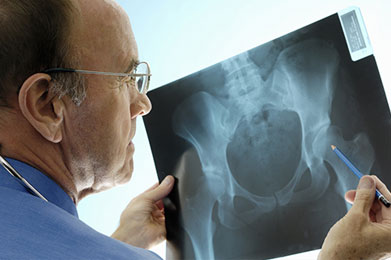Osteonecrosis or Avascular Necrosis (AVN)
Avascular necrosis is a disease resulting from the temporary or permanent loss of the blood supply to the bones. Without blood, the bone tissue dies and causes the bone to collapse. If the process involves the bones near a joint, it often leads to collapse of the joint surface. This disease also is known as osteonecrosis, aseptic necrosis, and ischemic bone necrosis.

Although it can happen in any bone, avascular necrosis most commonly affects the ends (epiphysis) of long bones such as the femur, the bone extending from the knee joint to the hip joint. Other common sites include the upper arm bone, knees, shoulders, and ankles. The disease may affect just one bone, more than one bone at the same time, or more than one bone at different times. Avascular necrosis usually affects people between 30 and 50 years of age; about 10,000 to 20,000 people develop avascular necrosis each year. Normally, bone continuously breaks down and rebuilds--old bone is reabsorbed and replaced with new bone. The process keeps the skeleton strong and helps it to maintain a balance of minerals. But in the case of avascular necrosis, however, the healing process is usually ineffective and the bone tissues break down faster than the body can repair them. If left untreated, the disease progresses, the bone collapses, and the joint surface breaks down, leading to pain and arthritis.
Avascular necrosis has several causes. Loss of blood supply to the bone can be caused by an injury (trauma-related avascular necrosis or joint dislocation) or by certain risk factors (nontraumatic avascular necrosis), such as some medications (steroids), blood coagulation disorders, or excessive alcohol use. Increased pressure within the bone also is associated with avascular necrosis. The pressure within the bone causes the blood vessels to narrow, making it hard for the vessels to deliver enough blood to the bone cells. Injury When a joint is injured, as in a fracture or dislocation, the blood vessels may be damaged. This can interfere with the blood circulation to the bone and lead to trauma-related avascular necrosis. Studies suggest that this type of avascular necrosis may develop in more than 20 percent of people who dislocate their hip joint.
Excessive alcohol use and corticosteroid use are two of the most common causes of nontraumatic avascular necrosis. In people who drink an excessive amount of alcohol, fatty substances may block blood vessels, causing a decreased blood supply to the bones that results in avascular necrosis. Corticosteroids sometimes lead to avascular necrosis. They may interfere with the body's ability to break down fatty substances. These substances then build up in and clog the blood vessels, causing them to narrow. This reduces the amount of blood that gets to the bone. Some studies suggest that corticosteroid-related avascular necrosis is more severe and more likely to affect both hips (when occurring in the hip) than avascular necrosis resulting from other causes.
Other risk factors or conditions associated with nontraumatic avascular necrosis include Gaucher's disease, pancreatitis, radiation treatments and chemotherapy, decompression disease, and blood disorders such as sickle cell disease.
There are some surgical treatment processes like core decompression, osteotomy and bone graft which are using to treat avascular necrosis but all these surgical methods provide very fluctuate result. Stem cell therapy is another good option to treat avascular necrosis because when we transplant stem cells into the core decompression site it replace that dead area by the differentiation process of stem cells into the bone cells.

